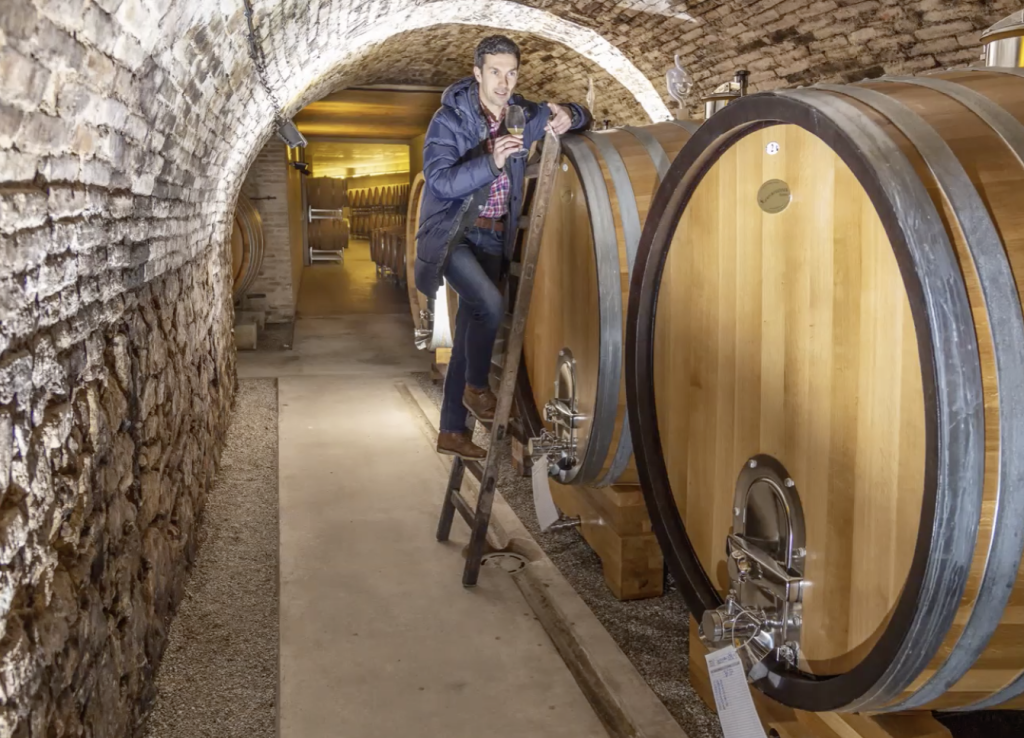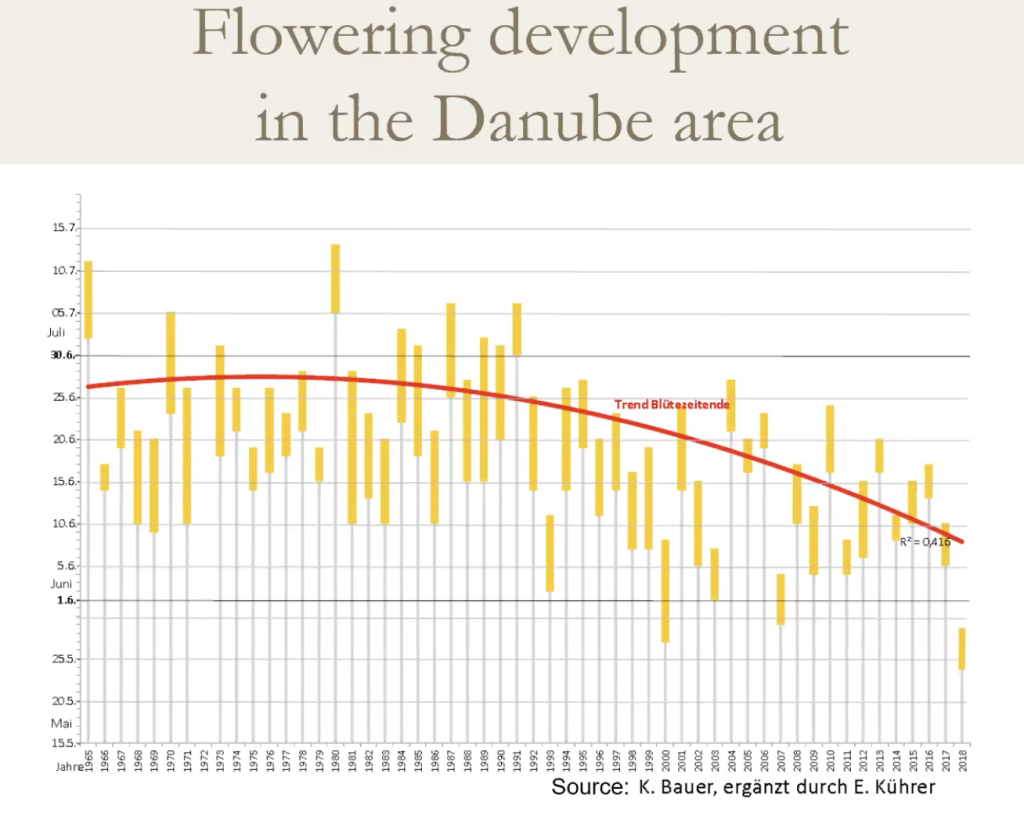
I spoke to Willi Bründlmayer, who is the owner and one of the winemakers at Weingut Willi Bründlmayer. I was also joined by Andreas Wickoff MW, General Manager and a very experienced sommelier. The event and the wines were arranged by myself — Kathleen Burk, Director of The Wine Guild.
As one of the top wine critics and writers on Austria, Stephen Brook, has written in The Wines of Austria, they have some of the top vineyards in Austria, mostly terraced, and for decades their Rieslings and Grüner Veltliners have been of generally outstanding quality; Hugh Johnson refers to Weingut Bründlmayer as ‘iconic’ winemakers.
I want to mention an organization, the Österreichische Traditionsweingüter, which was formed in 1992 with the object of classifying the classic vineyards. Their assessments are based on very stringent criteria, including following the quality over decades, in six of the wine regions of the Danube area. These vineyards are classified as Erste Lage or premier cru. These top wines have the symbol 1ÖTW on their labels; you can find it on a number of Bründlmayer wines.

An interesting comment that Willi made later in the presentation when talking about his Alte Reben Grüner Veltliner was that when making wines from younger vines, the winemaker may have to interfere more, whilst with older vines, the quality is automatic. He also pointed out that the Riesling is more nose-driven, whilst the Grüner is more mouth-driven, and furthermore, the Riesling is more fruit-driven and the Grüner more herb-driven. The Grüner vines prefer some shelter, whilst Riesling vines welcome some wind.

He also, later in the presentation, replied to a question about the wood they used. They use acacia for very mature Grüner Veltliner; it is a more neutral wood than oak, which brings in vanilla flavours which they do not appreciate with Grüner or with Riesling. For first use of the cask for fermenting, they use it with Pinot Noir or Chardonnay. They use Austrian oak. In the 1980s, they matured wine in several types of oak, including French oak from two different regions, and after two years they had a blind tasting of the results. There were differences but no preferences, and the choice was made to take the closest, which was Austrian. This had the further advantage that it added to the typicity of the wine.

Willi began his presentation by situating his winery. It is in the wine appellation (DAC) of Kamptal and about one hour west by car from Vienna, and is in the outskirts of Langenlois, the so-called Weinstadt (there are a number of top wine producers in the area). This is the area where the River Kamp runs into the Danube. The area has traditionally had a cool climate, but, because of global warming, this is changing, and now has what he called a medium-cool climate. They receive temperate air, including rain, from the Atlantic on the west, cool air from the north through the valley of the River Kamp, warm winds from Italy and sometimes the Sahara from the south, and hot air from the east. Their hottest months are September and October, which means a nice long growing season. Grüner Veltliner needs warm days and cool nights, the warm days to mature and the cool nights to ensure freshness – otherwise, the wine would be flat. A very interesting chart showed the impact of global warming, which showed that over the period from 1965 to now, the flowering period became two weeks shorter.

Kamptal is made up mostly of loess and primary rock. Loess is a wind-blown silt containing a number of minerals and some sand, which is very suitable for Grüner Veltliner, whilst the primary rock, on which Riesling thrives, is volcanic. Riesling grows better on south-western slopes, whilst Grüner thrives on richer soils with a south-eastern aspect. The vineyards are terraced, because when the rain comes, it comes in torrents, and this helps to prevent erosion. They have plants between the rows because, he said, they want the vineyards to stay for the long run, and the plants help to keep the soils healthy and protect against erosion, with the legumes providing nitrogen. The plants also provide competition for the vines, so that the roots are forced further down into the rock. He said that there were more extremes: when they have drought, it is more severe than in his youth, and when they have rain, there is more of it.
Willi emphasized that it is very much a family winery. His father planted a lot of pinot noir because his wife loved the wine; he also planted some chardonnay. Willi’s wife came from Paris bringing a love of champagne, and to please her, in 1989 they made their first sparkling wine; he was able to do so because of the grapes that his father had planted. She helps in the vineyards. His son Vincent was given his first vineyard when he was quite young, and his daughter Cécile made her first cask in 2013. The estate is 70% white grape varieties, six in total but primarily Grüner Veltliner and Riesling, and 30% red varieties, four in total and leading with Blauburgunder (Pinot Noir). They produce four thousand cases a year, 35% of which is exported.
Here it is worth noting that Grüner is a quintessential food wine, accompanying most dishes with aplomb; this includes vegetables, even artichokes. Grüner as a companion with green artichokes is hard to believe, so probably Jerusalem artichokes would be a better option.
It is also age-worthy, and certainly gets even better with two to three years bottle age – some think that the best age is at seven years. The single-vineyard (Ried) wines will happily slumber in the cellar for at least ten.
We began the tasting with the Extra Brut, which has three grams per litre dosage, and is traditionally made, bottle-fermented with two years’ minimum ageing on the lees, and hand-riddled. It is 50% chardonnay and 50% pinot noir and was disgorged in June 2018. It is 11.5%. The nose was a bit muted, with a bit of fruit showing, whilst on the palate, it is very dry, crisp and lively. Interestingly, I tasted it later, when it was not so cold and was a bit flat, and decided that I rather preferred it that way – it was delicious.
We then moved to the Wine Society’s Exhibition Grüner Veltliner 2019, which is made by Bründlmayer. This is a blend from different vineyards, and was made to show the typical Grüner from the Danube area. It is on the fresher, crisper side. On the nose, there is a strong note of apple, and some spice. There is no trace of the benchmark white pepper note, presumably because that usually develops with a bit of age. It is dry with nice tongue-wide acidity and some more apple fruit, and is medium-bodied. It would be a very nice lunch wine.
This was followed by the Kamptal Terrassen Grüner Veltliner 2018. This was grown on mostly loess-based soils with some crystalline rock; fermentation was spontaneous (all of the yeasts are native), and aged on the fine lees until February 2019. This was a challenging year, because it was one of the hottest that they had endured. They left lots of leaves to protect the grapes. The nose has slightly stony fruit with some minerality, and is a bit livelier than the Wine Society’s Exhibition wine. It is dry but at first it seems almost off-dry. It has wide-spreading acid with, at first, more minerals than fruit, but then the fruit came through.
The final Grüner Veltliner was the Langenloiser Alte Reben 2018. This is a village wine of superior quality. The ‘old vines’ in the estate are from fifty to a hundred years old, the latter from vineyards planted in the 1920s. The grapes come from different 1ÖTW vineyards (see paragraph three above) containing both loess and granite. Old vines produce lower yields, but the berries have more concentration. The wine is fermented in mostly Austrian oak casks and then aged for a year on the fine lees in large old oak barrels. The alcohol, I should add, is 14.5%, but it is so well-integrated that one hardly notices it. The nose shows some nice fruit but more herbs, whilst the palate has wide-spreading acid and some tart apple and a bit of quince. It is a reasonably full wine with some concentration and complexity and good length.
We then turned to Riesling for the next two wines, beginning with the Kamptal Terrassen Riesling 2018. This is a blend from different vineyards around Langenlois and the village of Zöbinger, with soils of mostly crystalline bedrock material. There is more fruit and less minerality on the nose than the Terrassen Grüner showed. On the palate it was dry with good acid and very nice integrated fruit with some floral notes, but not at all fruity-sweet. Interestingly, there is a bit of petrol on the palate, unusual in a Riesling this young. Delicate and fresh. Andreas noted that they make a number of single-vineyard Rieslings to show clearly the sense of place.
The Zöbinger Ried Heiligenstein Riesling 2018 is one of the great Austrian wines, not least because the grapes are grown on a vineyard with soil unique in Austria, known as ‘perm’ (referring to Permian rock). This is composed of weathered sandstone with volcanic conglomerates; it is essentially fractured sandstone through which the vine’s roots can descend in search of nutrients; they find minerals but also ancient Permian vegetation. The vineyard benefits from warm winds from the east during the day and cooling winds from the north during the night. Their oldest vineyards on the Heiligenstein are approximately one hundred years old, and of the thirty-six hectares, Bründlmayer owns eleven. The wine matures on the lees for three years, and is aged in old oak barrels. At this point of extreme youth, the nose is pretty mute, with fruit notes at the back of the nose. On the palate, however, it is a rich, round wine with good supporting acidity, more mineral than floral, and quite lovely after forty-five minutes in the glass.
The final wine was their Blauburgunder (Pinot Noir) 2016. They try for the lighter, fresher style of Burgundy that he enjoyed in his youth. However, with global warming, he thinks that over the next thirty to forty years, colour will become darker and the wine richer. (As a hedge, he said, they have several red grapes that will welcome warmer weather, including St. Laurent and Zweigelt.) In 2020 this particular wine got ninety-two Parker points, unexpected, perhaps, for an Austrian Pinot Noir. On the nose, there was fruit and a hint of rubber tire (which I like), whilst on the palate it was dry with a lot of integrated Old World fruit and spreading acid. It was a reasonably full wine and not at all shy.
Without, I assure you, receiving a commission, you might like to know that all of the wines, except for the Riesling Heiligenstein, can be found at Berry Bros and Rudd. The missing wine can be found at AG Wines.
Kathleen Burk, Director.




